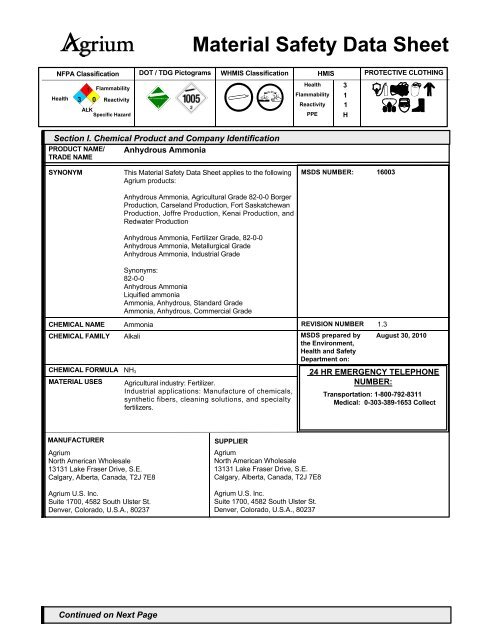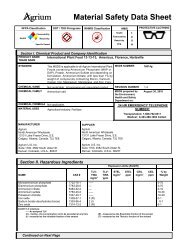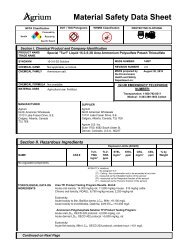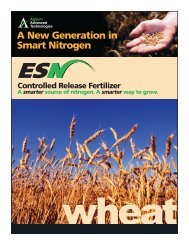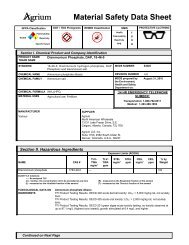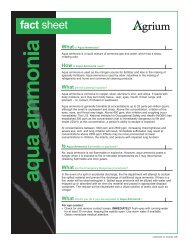MSDS - Agrium Wholesale
MSDS - Agrium Wholesale
MSDS - Agrium Wholesale
You also want an ePaper? Increase the reach of your titles
YUMPU automatically turns print PDFs into web optimized ePapers that Google loves.
Anhydrous Ammonia Page Number: 4FIRE FIGHTING MEDIA ANDINSTRUCTIONSCorrosive. If gases or vapours are present, rescuers must wear self-contained breathingapparatus and an impervious (Level A) encapsulating suit if subject to US OSHArequirements. (29CFR 1910.120 has been deemed to overrule the lesser protectionrequirements given in 1910.111) In other jurisdictions or if responding under D.O.T. rules(49CFR) full bunker gear or Level B clothing may suffice.Approach from upwind. If anhydrous ammonia catches fire, stop flow of gas or liquid if it maybe done safely. Cool containing vessels with water in order to prevent pressure build-up,autoignition or explosion. Move containing vessels from fire if without risk. Use water fog tosuppress vapors. Do not direct water into spilled ammonia. Ammonia is a cryogenic liquidwhich will cool with evaporation thereby limiting vapour release. Fire water at supplytemperature will increase liquid ammonia's temperature resulting in greater evaporation.Contain run-off water for treatment.SPECIAL REMARKS ONFIRE HAZARDSSPECIAL REMARKS ONEXPLOSION HAZARDSWhen heated to decomposition it emits toxic fumes. Hazardous Combustion Products:Nitrogen oxidesExplosive when mixed with chlorinated materials such as hypochlorites. Will form nitrogentrichloride which explodes spontaneously in air. Ammonia rReacts similarly with otherhalogenated materials.Section VI. Accidental Release MeasuresSMALL SPILLWarn personnel to move away. Keep unprotected personnel upwind of spill area. DO NOTAPPROACH LIQUID OR VAPOR CLOUD WITHOUT ENCAPSULATING SUIT AND SCBA.If possible to do so without hazard, isolate leak by shutting off supply of ammonia fromcontaining vessel. Use water fog to suppress airborne vapors from leak or spill.LARGE SPILLDO NOT DIRECT WATER INTO SPILLED LIQUID! ANHYDROUS AMMONIA WILLAUTOREFRIGERATE REDUCING VAPOR RELEASE. ADDITION OF WATER WILLWARM CRYOGENIC LIQUID RESULTING IN GREATER GASIFICATION. Contain run-offwater for later recovery and treatment. Call emergency number on this <strong>MSDS</strong> sheet forassistance.Follow precautions for small release, and refer to Emergency Response GuidebookERG2004, Guide 125 for further information regarding spill control and Isolation/ProtectiveAction Distances Guidelines.Community Emergency Response Instructions for Sheltering-in-Place:* Stay indoors (unless evacuation has been called by local authorities)* Close all windows and doors, seal with duct tape or wet towels* Shut off furnace, exhaust fans, fireplaces, and air conditioners* Wait for and follow advice from local police or authorities* If smell is very strong, breath through a wet clothSection VII. Handling and StoragePRECAUTIONSSTORAGEKeep ammonia handling facilities and containers locked. Protect against physical damage.Keep storage vessels away from direct heat. Ground all equipment. Keep away fromincompatible materials such as oxidizing agents, reducing agents, metals, and acids. Keepchildren away from ammonia storage and handling equipment.Keep away from combustible materials, heat, and incompatible materials, especially dry orliquid bleach. Ensure facilities are well maintained and emergency response and first aidequipment is readily available. Always ensure there is a nearby source of water for first aidpurposes and spill response. Facilities storing or handling ammonia should be equipped withan eyewash and safety shower, or other equipment for emergency decontamination. Seerequirements under 29 CFR 1910.111.Continued on Next Page
Anhydrous Ammonia Page Number: 5Section VIII. Exposure Controls/Personal ProtectionENGINEERING CONTROLS Workers must be trained in the safe handling and use of ammonia. Adequate, wellengineered systems must be provided for storage, transfer and use. Process block valves,equipment enclosures and other isolation facilities may be necessary. Provide adequategeneral or local exhaust systems to maintain concentrations within exposure guidelines.PERSONAL PROTECTIONThe personal protective equipment required varies, depending upon your risk assessment.Respiratory Protection:Use a NIOSH approved chemical cartridge respirator with full facepiece for ammoniaconcentrations up to 300 PPM. Use a positive pressure (pressure demand) SCBA forconcentrations above 300 PPM, for emergency response, or for entry into unknownconcentrations.Eye Protection:Ensure adequate eye protection for your specific work conditions. Use chemicalgoggles and a face shield or full facepiece air purifying or air supplied respirator.PERSONAL PROTECTION INCASE OF LARGE RELEASEEXPOSURE LIMITSSkin ProtectionEnsure splash protection where your risk assessment indicates this hazard. Usebutyl rubber, polyurethane, nitrile or gortex coveralls, aprons, suits, boots, or gloves as needed.Under emergency conditions, where contact with liquid anhydrous ammonia or highconcentration gas is probable, chemically resistant, gastight totally encapsulating suits with 60minute positive pressure SCBA are required. For U.S. work sites where respiratory protectionis required, ensure that a respiratory protection program meeting 29 CFR 1910.134requirements is in place.ACGIH TLV-TWA: 25 ppm, TLV-STEL: 35 ppm.ALBERTA OEL: TWA: 25 ppm, STEL: 35 ppmU.S. OSHA PEL:8H TWA 50 ppm (35 mg/m3)NIOSH REL, AMMONIA in air:10H TWA 25 ppm; STEL 35 ppm; IDLH 300 ppmAIHA Emergency Response Planning Guidelines:* ERPG-1:
Anhydrous Ammonia Page Number: 6VAPOR PRESSUREVAPOR DENSITY620 kg/m 3 ;5.04 lbs/gal (US)125 psi at 68°F (20°C) WATER/OIL DIST. The product is more soluble inCOEFF.water.0.6 (Air = 1)Section X. Stability and Reactivity DataSTABILITYThe product is stable.INSTABILITYTEMPERATURECONDITIONS OFINSTABILITYINCOMPATABILITY WITHVARIOUS SUBSTANCESCORROSIVITYNot available.No additional information.Extremely reactive or incompatible with acids. Highly reactive with oxidizing agents andreducing agents. Do not use copper, brass, bronze, or galvanized steel in contact withammonia. Do not use brazed joints in ammonia service. Forms explosive compounds withmany heavy metals such as mercury or silver. Reacts explosively with chlorine, hypochlorites(such as bleach or dry chlorinating chemicals) and other halogens (bromine, iodine, fluorine).Highly corrosive to copper and its alloys. Slightly corrosive to aluminum and zinc. Very slightlycorrosive to mild steel. Non-corrosive to glass or stainless steel (304 or 316).SPECIAL REMARKS ONREACTIVITYSPECIAL REMARKS ONCORROSIVITYIncompatible with halogens, aluminum, copper, brass, and zinc. Incompatible with strongacids.Corrosive to brass. Incompatible with copper alloys (stress cracking). Will corrode a widevariety of metals. Contact your sales representative or a metallurgical specialist to ensurecompatability with your equipment.Section XI. Toxicological InformationSIGNIFICANT ROUTES OFEXPOSURETOXICITY TO ANIMALSInhalation. Eye contact. Skin contact.See Section II.SPECIAL REMARKS ONTOXICITY TO ANIMALSOTHER EFFECTS ONHUMANSSPECIAL REMARKS ONCHRONIC EFFECTS ONHUMANSSPECIAL REMARKS ONOTHER EFFECTS ONHUMANSHazardous for humans or animal life. Corrosive to skin and eyes on contact. Severe overexposurecan produce lung damage, choking, unconsciousness or death. May cause severeeye irritation.Slightly to very dangerous in case of skin contact, eye contact, or inhalation. Material may beirritating or corrosive.Exposure can cause coughing, chest pains, difficulty in breathing. Repeated significantoverexposure can cause permanent lung function damage, edema and chemical pneumonitis.May cause serious damage to the eyes.No additional remark.Section XII. Ecological InformationECOTOXICITYBOD and CODHazardous for humans or animal life. Ammonia is a toxic hazard to fish. In lowconcentrations in water and soil, ammonia acts as a fertilizer to promote plant growth. Underaerobic conditions ammonia will oxidize to nitrate and is neither persistent norbioaccumulative in the environment. Sub-lethal concentrations in water can have adversephysiological effects on marine species. Free ammonia concentrations of 2.5 mg per litre atpH 7.4 to 8.5 are considered harmful to marine life. In water, free NH 3 is considered to bethe primary toxic form while the much more prevalent NH 4OH form is much less harmful.Not available.PRODUCTS OFDEGRADATIONNitrogen oxides (NO,NO 2 ...), nitrates.Continued on Next Page
Anhydrous Ammonia Page Number: 7TOXICITY OF THEPRODUCTS OFDEGRADATIONSPECIAL REMARKS ON THEPRODUCTS OFDEGRADATIONThe products of degradation are less toxic than the original product.Product may degrade water quality and taste. Notify downstream water users. Will dissolveand disperse in water.Section XIII. Disposal ConsiderationsWASTE DISPOSAL ORRECYCLINGCall for assistance on treatment and disposal. Recover and place material in a suitablecontainer for intended use or disposal. Ensure disposal complies with governmentrequirements and local regulations.Section XIV. Transport InformationDOT / TDG CLASSIFICATIONCanada:TDG (Clear Language Regulations) Class 2.3: Toxic compressed gas. Subsidiary Class 8Corrosive.U.S.DOT Classification under §172.101 for shipments originating in the United States for U.S.domestic destinations only:DOT Class 2.2: Non-flammable compressed gas.DOT Classification for International Shipments, including empties being returned is:DOT Class 2.3: Poison GasShipping documents must have the words "Inhalation Hazard" entered in association with theshipping description, and each bulk package shall have the words "Inhalation Hazard"marked on two opposites sides of the package. Size of the markings must conform to therequirements of §172.302(b).For shipments between Canada and the United States:Ammonia shipments between both countries, including empty or residue railcars or trucks isregulated under DOT Special Permit 14755. Recent changes in Transport Canada'sTransportation of Dangerous Goods Regulations has changes the classification of AnhydrousAmmonia from Class 2.2 to Class 2.3. Shipment of anhydrous ammonia within Canadausing the DOT green 2.2 Placard are prohibited.Shipments originating within Canada going to the United States will be placarded with thenew Transport Canada White UN 1005 Anhydrous Ammonia Placard. DOT Special Permit14755 allows shipments to proceed from Canada to destinations in the United States withthis placard. DOT Special Permit 14755 also allows shipments to proceed from the UnitedStates to Canada using the new UN 1005 Anhydrous Ammonia Placard. Carriers must havea current copy of the the Special Permit on board. A copy of the Special Permit must also bemaintained at the place of shipment origin.Domestic shipments within the U.S. must continue to use the green DOT 2.2 Non-flammablecompressed gas placard.PIN and Shipping NameSPECIAL PROVISIONS FORTRANSPORTDOT (U.S.A) (Pictograms)Shipping name: AMMONIA, ANHYDROUSPIN: UN100549 CFR 172.102: (I) 4, N87,T50(D) 13, T50NON-FLAMMABLE GAS2Continued on Next Page


